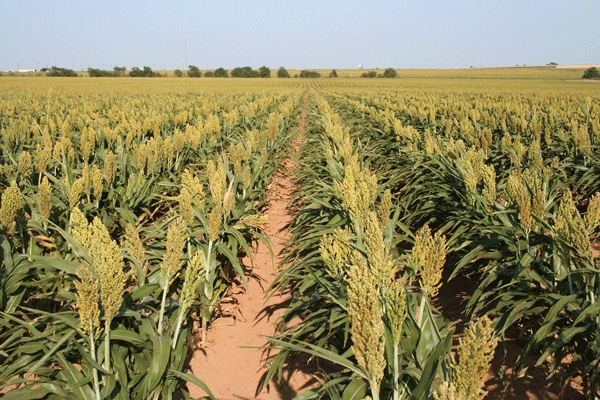
Excessive heat and a lack of rainfall has forced early planted grain sorghum in the Coastal Bend to mature early and much of the crop that survived harsh May and June weather has reached black layer. Some harvest in the region started last week and is expected to pick up in the days ahead.
Jeffrey Stapper, county Extension agent in Nueces County, is reporting the sorghum crop is a mixed bag. He says crops that received late spring rains are being harvested, but the sorghum crop in much of the region has been declared a total loss. Stapper says some producers are cutting for hay while others are plowing under their loss.
Producers who failed to receive the late rains say moisture content is far too low to meet market specifications, but Stapper says borderline sorghum may still meet specifications if growers apply harvest aids. He recommends aids only after sorghum reaches black layer and average grain moisture drops below 30 percent.
When applied properly, he says combining is faster with little notable reductions in grain weight. But he warns timing is critical for application of harvest aids, and even with them yields will be reduced.
According to a Texas AgriLife publication, harvest aids may be needed because sorghum is a perennial plant that can live beyond a single season’s growth cycle. If its growth is not terminated by chemicals, freezing weather or shredding and tillage, the plant can survive for extended periods, which often causes problems at or beyond harvest.
Grain containing too much moisture can harbor molds and bacteria, causing heating or “souring” and a loss of quality. If the moist grain is stored, the risk increases for aflatoxin, which prevents international trade. Sorghum that meets the moisture specifications commands higher prices because artificial drying or blending is not required.
There are two ways to determine physiological maturity: Use a grain moisture tester. Most grain moisture testers register up to 30 percent moisture. By stripping grain off several heads from several areas of the field and testing the moisture, you can easily estimate the moisture content of the sorghum. Check the kernels for a black layer, which indicates that the crop is mature.
Harvest aids
Only two products are labeled for use as harvest aids: sodium chlorate (containing a fire retardant) and glyphosate. For satisfactory results, good spray coverage is needed for both products. Eight to 10 gallons per acre of solution by ground or 3 to 5 gallons per acre by air is recommended.
Sodium chlorate, which can cause fires if it is not mixed with a retardant, is a chemically active salt that desiccates the plant. Growers may apply up to 6 pounds per acre. This product is sold under various trade names and concentrations of active ingredient per gallon. For good desiccation, the weather must be hot and dry.
Glyphosate herbicide kills the plant. Producers may make a single application of up to 2 quarts per acre. Once it is applied to sorghum, the plant moves the glyphosate to the growing point over a 5 to 6 day period. Weeds that are actively growing when
the product is applied will also be destroyed.
Use a sprayable grade of ammonium sulfate at a rate of 17 pounds per 100 gallons of water or a prepackaged sulfate formulation to condition the water and improve effectiveness. There is a 7-day waiting interval between application and harvest. The crop is usually ready 7 to 10 days after application.
Glyphosate also controls rhizome Johnsongrass, silverleaf nightshade, morning glory, field bindweed and most other perennial weeds.
Stapper recommends growers should only treat those acres that can be harvested within 10 days to two weeks after application. Weather and storms in the Gulf should also be a consideration. To avoid any premature lodging, inspect the field before the application. He advises producers to look for stalk degradation from diseases such as charcoal rot, which will cause premature lodging during natural dry down or after harvest aids are applied.
About the Author(s)
You May Also Like




